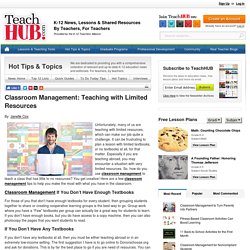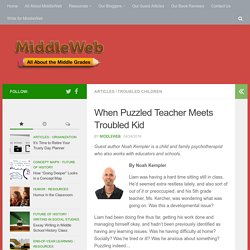

Creating a Mindful Classroom with Six Helpful Apps. Mindfulness, meaning mental presence and reflection, is a popular practice across the U.S., incorporating tools to help people think clearly and critically, calm their minds, and be more productive.

Many teachers also believe mindfulness can help students feel more relaxed and focused, not to mention make them less likely to engage in disruptive behavior than those who don’t meditate or undertake other mindfulness practices. Research shows that mindfulness practices can have a generally positive effect on students, though it’s not yet clear whether those outcomes are caused by specific practices or simply giving students the chance to take a breath during a busy school day. In one study, students said they spent one-third of their study time feeling worried, stressed, or stuck. Why Consistency Is Everything The First Two Weeks Of The School Year. The first two weeks of the school year is the honeymoon period. Students are eager and wanting to please. They’re bright and happy and on their best behavior. They take seriously your teaching of rules and consequences, and it shows. Which is wonderful, of course, and proof you’ve done well laying out your expectations. But there is a danger lurking.
You see, it’s easy to get so caught up in how well things are going that you make small, barely perceptible decisions that cause trouble down the line. 3 Uniquely Powerful Ways To Praise Your Students. Here at SCM, we’ve talked a lot about the importance of making your praise worthy.

That is, praise that is based on true accomplishment. —Which can be defined as achievement, excellence, or effort beyond what is commonly expected. In this way, we support the growth of intrinsic motivation and inspire our students to greater accomplishment. Praising for that which they’ve already proven they can do, on the other hand, weakens this churning, self-sustaining force. Edutopia. A (Slightly) Dangerous But Effective Way To Get Your Students' Attention - Smart Classroom Management. 10 Ways to Sabotage Your Classroom Management. By Jennifer Gonzalez You know the basics: Establish clear rules and consequences, be consistent, keep students engaged.

But even with all that in place, the small things you do could be wreaking havoc on your whole system. Here are some habits you might have developed that are messing with your classroom management, along with more effective alternatives. 1. Smiling at the Wrong Times. Classroom Management: Teaching with Limited Resources. Unfortunately, many of us are teaching with limited resources, which can make our job quite a challenge.

Classroom Management Tips for New Teachers. When you are just starting out as a new teacher, you don’t have the advantage that experienced teachers do.

Experienced teachers at least get the opportunity to look back each year at what classroom management tactics worked in their classroom and what did not. A new teacher just starting out, unfortunately, is going to be bombarded with a ton of new information and doesn’t have the background classroom management knowledge that a veteran teacher does. Here are a few classroom management tips, advice, and suggestions for new teachers. Classroom Management: Observe! A 5-Second Solution for a Talkative Class. 3 Tips for New Teachers Who Want Well-Behaved Students. Classroom Management in the EdTech Classroom - The Tech Edvocate. Why You Shouldn’t Try To Convince Difficult Students To Behave.
It happens every day in classrooms from Fresno to Kathmandu. The teacher pulls aside their most difficult student for a private meeting. Sometimes it’s a lecture. Sometimes it’s a pep-talk. Sometimes it’s to threaten or praise or question like a trial lawyer. But in every case, the teacher is trying to convince the student to behave. They’re trying to use their tone of voice and creative use of words to inspire a change in behavior. And although there can be some immediate improvement, it never lasts. For teachers, it’s not just what you say, it’s how you say it. Credit: Alison Yin for EdSource Today Denisia Wash, a kindergarten teacher in Berkeley, didn’t want to use a sugary voice when she talked to her 5-year-old students – they weren’t babies and that voice wasn’t actually effective, she said.

But she didn’t want to use a sharp-edged voice either, the impatient tone that can come out when she’s tired or under pressure. “I call that teacher voice my ‘stress voice,’” she said. Last year, she conducted an experiment as part of her evaluation at Berkeley Unified. If she changed her tone of voice, would her students feel more involved in what they were learning? Wash isn’t alone in thinking about how she sounds when she talks to her students.
Myth-Busting: "If I Just Had Better Students" I was at the attendance office one day towards the end of the school year, and the clerk asked me about one of the students who had been skipping class.

Unbidden and almost automatically, the words came out of my mouth, “You know, the counselors for some reason decided to give me the worst class possible. How am I supposed to teach them when I have to spend so much time dealing with so many behavioral issues?” After I left the attendance office, I reflected on what I had said and realized that I had fallen into the trap of self-pity and justification that I have decried so much in my blog posts. Setting Classroom Expectations. Put 20 to 30 children in a room for six hours a day, and things will occasionally get a little rowdy.

But if a classroom is consistently out of control, that will have a negative impact on student learning outcomes and the stress level of the teacher. There is a way for teachers to take control up front: by setting clear classroom expectations. According to ASCD, setting clearly defined parameters for classroom behaviors accounts for 25% of the factors that affect classroom discipline. 5 Tips for Creating Real Rapport With Your Students. As a special education teacher, I often have the opportunity to work with students who many of my colleagues find...let's say, difficult to work with.

On my worst days I get frustrated by how it often seems that classroom teachers are at a loss when students don't fit their expectations. Building rapport is hard work. We can't assume that the old "respect me because I am the teacher" model will work for all of our students, or even most of them these days. Perhaps there are communities where this still works very well, but this hasn't been my experience and it's always advantageous to learn through difficult circumstances.
So, how do we build meaningful connections with our students so that they can get the most from their experience with education? Using Notebooks for Classroom Management, Part 2. [3624] Epic Classroom Management Mistakes and How to Avoid Them. Puzzled Teacher, Troubled Kid: Understanding Behaviors. Guest author Noah Kempler is a child and family psychotherapist who also works with educators and schools.

By Noah Kempler Liam was having a hard time sitting still in class. He’d seemed extra restless lately, and also sort of out of it or preoccupied, and his 5th grade teacher, Ms. Kercher, was wondering what was going on. Was this a developmental issue? Liam had been doing fine thus far, getting his work done and managing himself okay, and hadn’t been previously identified as having any learning issues. This scenario is not uncommon for teachers and can leave you scratching your head for how to make sense of the behaviors you see in front of you. 20 Tips to Help De-escalate Interactions With Anxious or Defiant Students. Anxiety is a huge barrier to learning and very difficult for educators to identify. “When anxiety is fueling the behavior, it’s the most confusing and complicated to figure out,” Minahan said. 19 Big and Small Classroom Management Strategies.
The year I started teaching seventh- to twelfth-grade English in Minneapolis, Prince launched his song about urban ruin, "Sign o' the Times. " That song was an apt musical backdrop for the lives of my students, most of whom lived in poverty and challenged me daily. That year also afforded me the opportunity to be assaulted with a stone, two chairs, a Rambo knife, a seventh-grade girl's weak jab, and dozens of creative swear words.
Fortunately, classroom order improved when I learned that successful classroom management depends on conscientiously executing a few big strategies and a lot of little ones. Big Strategies: Fundamental Principles of Classroom Management. Teachers Use Compassion To Boost Attendance At Gwinnett School. This story is part of WABE and American Graduate's Advancing Atlanta: Education series. For more stories, click here. Of all the problems facing public schools, one that has stumped educators for years is how to get kids to show up. Truancy, or chronic absenteeism, can be a particular problem in low-income areas. State research shows attendance is tied to achievement. Kids who miss more than six days of school during the year tend to see their academic performance slip. But Richards Middle School in Gwinnett County seems to have found a way to get kids excited about coming to class.
Hear the broadcast version of this story. Going from ‘Not Bad’ to ‘Very Good’ For some kids, middle school can be that awkward space that comes after the comfort of elementary school and before the freedom of high school. Classroom Behavior Management Site. Safe harbor for 'Captains of the Classroom' 10 Classroom Procedures that Will Save Your Sanity - Teach 4 the Heart. The difference between a good procedure and a bad procedure is the difference between “everything is running fairly smoothly” and “this is driving me nuts. 10 Exit Slip Prompts that Will Work for Any Class - Teach 4 the Heart. If you’re not using exit slips, you really should try them.